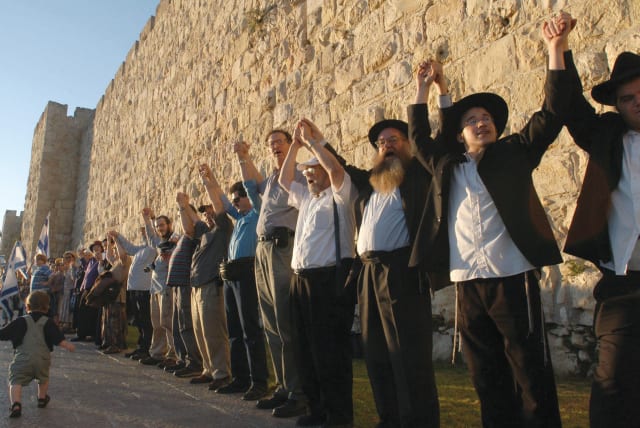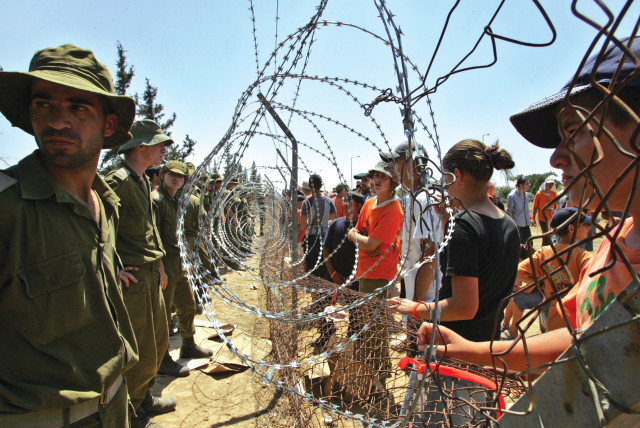When Israelis formed a human chain to stop the Gaza Disengagement - opinion

Eighteen years ago, 150,000 people formed a human chain, 90 km. long, that stretched from Gush Katif in the Gaza Strip to the Western Wall in Jerusalem.
Memory is strange. Things that you haven’t thought about in years come back to you unexpectedly.
Today it happened to me. I suddenly remembered that I played a minuscule part in a historic event in Israel. Eighteen years ago, 150,000 people formed a human chain, 90 km. long, that stretched from Gush Katif in the Gaza Strip to the Western Wall in Jerusalem.
It was not the first human chain, nor the longest (two million people once formed one in Latvia, and 1.5 million in Taiwan). It took place in the heat of a sizzling Israeli summer, but I stood among people of every age group, from toddlers to old people, many clutching Israeli flags or books of Psalms. Everyone was excited to be part of a special moment for the Jewish people.
A human chain to protest Israel's Disengagement from Gaza
The reason for this human chain was to protest prime minister Ariel Sharon’s Disengagement plan, and to support the people who were threatened with being uprooted from their homes. Some of them had lived in the Gaza settlement bloc for three generations, putting down roots not only with their families but also having built thriving agricultural settlements. The mood was euphoric as more and more people joined the chain. New immigrants and tourists from the US and South Africa also took part.
Although police in cars and motorcycles drove past every now and then, the protest was quiet and orderly, and we didn’t venture onto the middle of the road, as buses and cars drove about as usual.
Organizing the chain was supposed to have taken three months of planning, although I suspect many of the participants, like myself, only decided to join at the last minute. I thought I would find it difficult standing for two hours by the roadside (it lasted from 5 p.m. to 7 p.m. on a very hot day) and was surprised how quickly the time went by. The event took place, coincidentally, at the same time as the Likud opposition convention in Tel Aviv. Nevertheless, there were supposed to be 400 members of the Likud central committee and 20 members of Knesset from other parties, such as the National Religious Party and the National Union, participating.
What made the time pass quickly was the fact that everyone was discussing the Disengagement with his neighbor, people we were meeting for the first time, from every part of the country. The majority were religious and right-wing, but there were secular Israelis, too.
I was struck by the moderation being expressed on all sides. The deep attachment to our land did not prohibit compassion for the plight of the Palestinians who were suffering more from their own corrupt leadership, unwilling to compromise or adhere to any peace plan, than from anything Israel had done. Even when the Oslo Accords had offered them large parts of the West Bank, and prime minister Ehud Barak at Camp David had offered to surrender most of Jerusalem’s Old City, as well as trading Israeli land for the little of the West Bank that was annexed to Israel, Yasser Arafat declined to negotiate and the Second Intifada broke out, with Jews being murdered at times almost on a daily basis. “So what would be different this time?” was the view I most heard expressed. “The more we give them, the more they want.”
But this was less of a political demonstration than an ideological one. Rather than being against anything, 150,000 people were expressing what they were for – love and attachment to Eretz Israel. Many were sporting T-shirts and caps with the slogan “Ha’am im Gush Katif ” (“The people are with Gush Katif”).
AS IT drew near to 7 p.m., the discussions gave way to reading Psalms, and exactly at 7, everyone joined hands and sang “Hatikvah.” When we got to the line that means “to be a free people in our homeland, in Zion and Jerusalem,” I saw that I wasn’t the only one with moist eyes. “Hatikvah” was followed by “Ani Ma’amin” (“I believe”), and the emotion was palpable. I couldn’t hear it from where I was standing, but later I saw on television that at that moment trumpets were being blown like shofars at the end of the chain, which was the Western Wall, 90 km. from beginning to end.
That was the end. No speeches, no high drama, just 150,000 people who had stood together, shoulder to shoulder, expressing their love and support for the brave Israelis of the Gaza Strip.
If only we had been successful in preventing the Disengagement.... If only!
The writer is the author of 14 books. Contact her at dwaysman@gmail.com
Jerusalem Post Store
`; document.getElementById("linkPremium").innerHTML = cont; var divWithLink = document.getElementById("premium-link"); if (divWithLink !== null && divWithLink !== 'undefined') { divWithLink.style.border = "solid 1px #cb0f3e"; divWithLink.style.textAlign = "center"; divWithLink.style.marginBottom = "15px"; divWithLink.style.marginTop = "15px"; divWithLink.style.width = "100%"; divWithLink.style.backgroundColor = "#122952"; divWithLink.style.color = "#ffffff"; divWithLink.style.lineHeight = "1.5"; } } (function (v, i) { });

